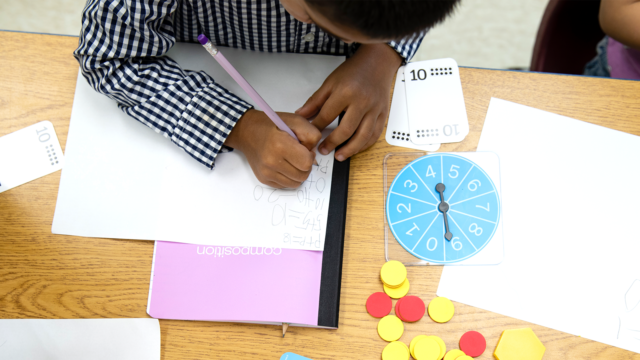
Whether you teach kindergarten or high school, invariably, you will sometimes be teaching to a small group instead of the entire class. In many classrooms, this is a recurring part of the instruction and happens during nearly every class! Many of the strategies offered in this article also support small-group learning that takes place away from the teacher. No matter how it looks, small-group instruction can present challenges for novices and experts alike. How do you select the group? How will you transition from whole class to small groups? What will the rest of the class be doing?
In our Math Solutions publication, So You Have to Teach Math? Sound Advice for Grades 6-8 Teachers (2006), author Cheryl Rectanus explains in a way that applies to students of all grades (p. 30): “Talking about mathematics facilitates learning. When you explain something to a partner or group, it helps you clarify and cement your thinking. When you listen to others, their ideas can help challenge your thinking, providing perspectives and strategies that you might not have considered otherwise.”
Strategies for Small-Group Instruction
Below are strategies to make small-group learning effective for you and your students. Remember that only you truly know your school and your students. These strategies are tools to consider. Ultimately, it is up to you to determine the best way to turn your students into budding mathematicians.
Strategy 1: Collaborate on Class Norms
Instead of dictating to your students how they’re supposed to behave when in a small group, ask them to make the rules. One way to start this is by having a class discussion about what they do and don’t like about working in groups. Discuss aspects such as hearing new points of view, thinking at a high level, and what happens when you try to explain a concept to someone else. Consider questions like the ones below that help facilitate a conversation among you and your students:
- What helps you learn?
- What interferes with your learning?
- How should you react if you disagree with what someone is saying?
- When has a discussion changed your mind about something?
- Why can math be hard to explain?
- What are our responsibilities as students?
- What are my responsibilities as a teacher?
Have students generate a list of norms that everyone can agree to follow, such as everyone must be patient with one another and no insults are allowed. This gives students ownership over what small-group learning looks like. Consider creating a poster that shares these norms and making it a living document. As students want to amend and add new rules, do so officially on the poster. The process of creating the list is more important than the final result, and you want students actively engaged with thinking about what does and doesn’t work for their learning.
Strategy 2: Vary How Groups Are Selected
It is common to think about students in terms of levels, but there are many ways to differentiate math instruction and consider how to construct a small group. Consider creating a group with diverse abilities—an especially powerful way to introduce students to different perspectives. Be sure to seek tasks with a low floor and high ceiling so that all students can find an entry point and participate in the discussion. (For more about low floors, high ceilings, and wide walls, see the work of Mitchel Resnick, who in turn credits Seymour Papert and others.) You could also consider groups that share a common interest. For instance, if some of your students love soccer, develop a problem around soccer and then lead a small-group learning session where those students work on it collaboratively.
Strategy 3: Choose the Right Tasks
Not all tasks are created equal. Could your planned task be done independently? If so, there is little incentive for the group to work collectively. Instead, seek tasks that work well in a group setting and promote discourse. Problems such as “which of these numbers/shapes/graphs is different from the rest?” or “how would you solve this problem?” have multiple answers and promote diverse responses and student interaction.
However, just because a task is best for a group doesn’t mean you shouldn’t still allow time for individual thinking. This is a valuable part of problem solving, as the effectiveness of a group depends on the quality of individual contributions. Give students a chance to think about problems on their own before being influenced by others, and encourage all students to participate in the discussions that follow. Seek routines that follow naturally from independent thinking, such as Think-Pair-Share. It may help to structure these routines with a timer to ensure students all have an equal amount of time to share their thinking.

Strategy 4: Plan Getting in and out of Small Groups
Think beyond what happens during small-group learning. Think, too, about getting into it and ending it. Students moving around the classroom and switching tasks can be a daunting prospect, especially if you teach students who aren’t accustomed to it. Consider how your students may create unwelcome distractions when making transitions. How can you make routines of getting in and out of small groups? Consider creating time limits or ensuring that students have a predictable place in the classroom to go. We even once observed an innovative teacher who secured tennis balls to chair legs to cut down on noise!
Strategy 5: Use the Go Around One Routine
As noted in the previous strategy, using routines to structure small-group learning is a powerful way to keep students on task and use class time efficiently. Routines are still important throughout the instruction, too! Routines such as Think-Pair-Share provide structure and opportunities for math discourse as you instruct. Be sure to follow any norms that your class has established regarding peer-to-peer dialogue to ensure ongoing participation and collaboration from all students. Cheryl Rectanus, whose work was cited at the beginning of this article, recommends one in particular called Go Around One. The routine works as follows:
- Person A reports one idea to the group. While Person A reports, the other group members (and you!) listen carefully without interrupting or giving nonverbal cues to indicate whether they agree, such as head nodding.
- When Person A is finished, Person B shares one idea, and all group members listen as before.
- Continue until all group members have reported their idea.
- Once finished, the group discusses the ideas, sharing airtime equally.
There are ways to vary the routine, for example, Go Around All, where each person reports all of their ideas instead of just one. There is also Go Around Timed, which is similar to Go Around All, except students report ideas until the teacher rings a chime, which signals to finish the sentence and rotate to the next person. If you are performing this routine with multiple groups, it helps if all groups are the same size.
Strategy 6: Use Routines to Process Mathematics
Routines are so important that they keep coming up! In this case, consider how routines can help students process mathematics. In order to create a successful classroom, you will want structured student interactions, well-managed class time, and relationships among students and you that promote productive teaching and learning. The effect can be far-reaching. Establishing the right routines can get students into content quicker and catch them up when needed. In particular, give critical attention to how routines have students discussing and processing mathematical ideas.
It is important to be purposeful in what questions you have groups discuss. You do not want the same students always answering questions, nor do you want some students always getting lower-level questions or being the ones whose thinking gets discussed. Seek higher-level questions, which can be as simple as “Why?” Encourage them to expand their thinking (“Can you explain?”) or put ideas in their own words (“Can you repeat what Student X said in your own words?”). Additionally, avoid evaluating their responses yourself. Instead, ask these or similar questions to multiple students and have students compare responses themselves. This type of strategic questioning, known as Talk Moves, is described and used throughout the Professional Learning cards available within Into Math and Into AGA.
Strategy 7: Contextualize Math Problems
In Strategy 3, we promoted choosing the right task. Here we call out one task in particular. There is a research-based task that promotes mathematical discourse, especially when some students are multilingual learners, and covers a broad range of math concepts. Have students contextualize math problems. For example, you could present an arithmetic expression such as \(\left(\frac{1}{3}+\frac{1}{4}\right)\cdot2\) and have students come up with real-world scenarios that contextualize the problem. For instance: if one student can eat a third of a pizza and another student can eat a fourth of a pizza, how much pizza do you need to last for two meals?
Contextualizing math problems connects prior whole-group instruction to subsequent small groups and finds differences in how different students seek real-world contexts. Draw attention not just to mathematical differences (for example, the order of addition or whether it’s a fractional distance or a fraction of a whole area) but also linguistic differences, for example, pizza vs. pies or “one-fourth” vs. “one-quarter.”
Be sure to explore other instructional supports that are available on Shaped to find the ideas and strategies that work for you and your students. And let us know what you think! Write us at Shaped@hmhco.com.
***
Looking for professional development support? Explore professional learning resources that meet your needs.

These strategies provide differentiated math instruction to K-12 teachers looking for ways to personalize their mathematics teaching.

Timothy D. Kanold highlights the importance of small-group student discourse in the math classroom, with details on formative and differentiated student learning.
Get free quick tips for bringing RTI into the core classroom.












